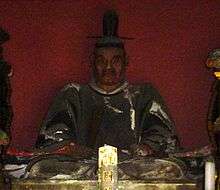Yagyū Munenori
Yagyū Munenori (柳生 宗矩, 1571 – May 11, 1646) was a Japanese swordsman, founder of the Edo branch of Yagyū Shinkage-ryū, which he learned from his father Yagyū "Sekishūsai" Muneyoshi. This was one of two official sword styles patronized by the Tokugawa shogunate (the other one being Ittō-ryū). Munenori began his career in the Tokugawa administration as a hatamoto, a direct retainer of the Tokugawa house, and later had his income raised to 10,000 koku, making him a minor fudai daimyō (vassal lord serving the Tokugawa), with landholdings around his ancestral village of Yagyū-zato. He also received the title of Tajima no Kami (但馬守).
| Yagyū Munenori | |
|---|---|
 |
Career
Munenori entered the service of Tokugawa Ieyasu at a young age, and later was an instructor of swordsmanship to Ieyasu's son Hidetada. Still later, he became one of the primary advisors of the third shōgun Iemitsu.
Shortly before his death in 1606, Sekishusai passed the leadership of Yagyū Shinkage-ryū to his grandson Toshiyoshi.[1] Following a period of musha shugyō, Toshiyoshi entered the service of a cadet branch of the Tokugawa clan that controlled the Owari province. Toshiyoshi's school was based in Nagoya and came to be called Owari Yagyū-ryū (尾張柳生流), while Munenori's, in Edo, the Tokugawa capital, came to be known as Edo Yagyū-ryū (江戸柳生流). Takenaga Hayato, the founder of the Yagyū Shingan-ryū, was a disciple of Yagyū Munenori and received gokui (secret teachings) of the Yagyū Shinkage-ryū from him.
In about 1632, Munenori completed the Heihō kadensho, a treatise on practical Shinkage-ryū swordsmanship and how it could be applied on a macro level to life and politics. The text remains in print in Japan today, and has been translated a number of times into English.
Munenori's sons, Yagyū Jūbei Mitsuyoshi and Yagyū Munefuyu, were also famous swordsmen.
Depictions in film
- Akai kage-bōshi (The Red Shadow), 1962 – played by Denjirō Ōkōchi
- Nemuri Kyōshirō 2: Shōbu (Adventures of Nemuri Kyōshirō), 1964 (released on DVD as "Sleepy Eyes of Death: Sword of Adventure")
- Yagyū ichizoku no inbō (The Yagyu Conspiracy), 1978 – played by Yorozuya Kinnosuke (released on DVD as "The Shogun's Samurai")
- 'Makai tenshō (Samurai Reincarnation), 1981 – played by Tomisaburo Wakayama
- Makai tenshō, 2003 – played by Nakamura Katsuo
Bibliography
References
- Wilson, William Scott, "Introduction", The Life-Giving Sword by Yagyu Munenori, trans. William Scott Wilson, Kodansha International, 2003.
Further reading
| Wikiquote has quotations related to: Yagyū Munenori |
- De Lange, William (2019). The remarkable History of the Yagyu Clan. TOYO Press. ISBN 978-94-92722-171.
- De Lange, William (2012). Famous Samurai: Yagyū Munenori. Floating World Editions. ISBN 978-1-891640-67-4.
- Tokunaga, Shinichirō (1978). Yagyū Munenori. Seibidō. ISBN 4-415-06534-1.
- Sugawara, Makoto (1988). Lives of Master Swordsmen. The East Publication. ISBN 4-915645-17-7.